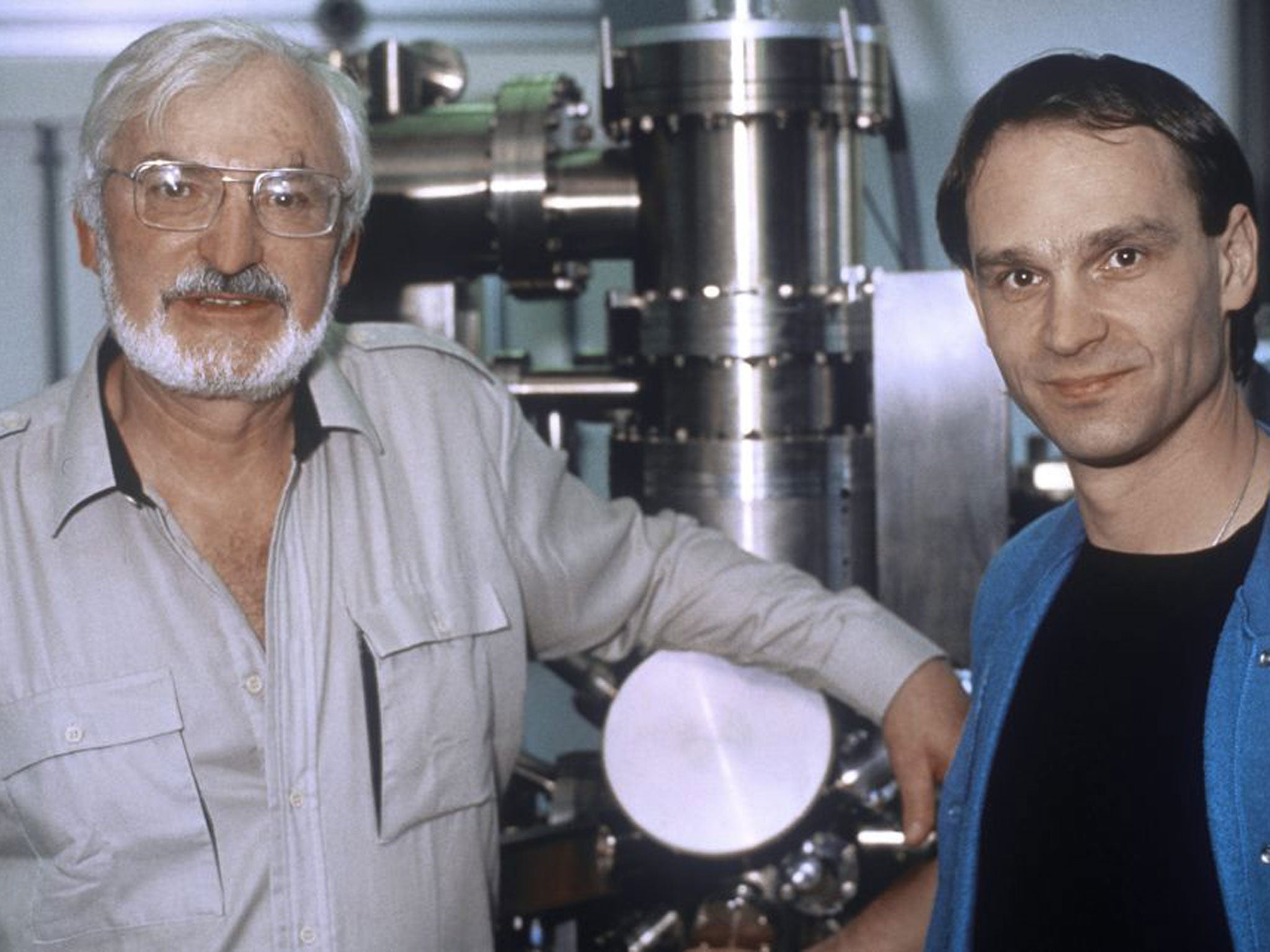Heinrich Rohrer: Physicist awarded the Nobel Prize for inventing a microscope of unprecedented power

Heinrich Rohrer was a Swiss physicist, who, with his colleague Gerd Binnig, won the Nobel Prize for Physics for their invention of the scanning tunnelling microscope (STM), which helped open the door to the field of nanotechnology – the manipulation of individual atoms and molecules to create useful devices and transform the modern world we live in.
Considered to be the fathers of nanotechnology, the pair shared the 1986 Nobel Prize with the German-born physicist Ernst Ruska, for his work in electron optics and the design of the first electron microscope.
Noted for their synergy and good humour, the pair were said to be “polar opposites”. During the development of the STM, Rohrer was the ideas man and Binnig was the engineer who built the device.
Rohrer’s humour and humility were illustrated at the opening in their honour of the new IBM Zürich research facility, the Binnig and Rohrer Nanotechnology Centre. Following a carefully answered question to journalists by Binnig about their STM discovery, Rohrer joked, “If you didn’t quite understand what Gerd just told you, you are not alone.”
The Nobel committee said that Rohrer and Binnig had opened up “entirely new fields… for the study of the structure of matter.”
Their device, introduced in 1981, uses the quantum tunnel effect to allow analysis of the molecular structure at the atomic level. Successfully tested that year, by 1987 they had captured images as small as 0.25 billionths of an inch. The STM, a type of electron microscope, showed three-dimensional images.
Rohrer later recalled that his co-workers at IBM were sceptical about their project: “They all replied, ‘You’re completely crazy, but if it works, you’ll get the Nobel Prize’.” Some colleagues even bet cases of champagne that their results were mere computer simulations!
Described as a seminal moment in the history of science and information technology, the invention of the STM gave scientists the ability to image, measure and manipulate atoms and molecules to within a millionth of an inch for the first time, and opened new possibilities for the electronics industry and for information technology that are still pursued today.
The invention is dependent on a quantum-mechanical phenomenon known as tunnelling, so called because the electrons pass through a supposedly impenetrable barrier, such as a vacuum. The phenomenon is the basis of scanning tunnelling microscopy, which allowed unprecedented clarity in the study of the structure of matter.
Born in the small farming town of Buchs in the Swiss canton of St Gallen in 1933, the year Adolf Hitler came to power, Heinrich Rohrer was the third of four children to Hans, a wholesaler, and Katharina. Described as having a carefree childhood with a sound mixture of freedom, school and farm work, the family moved to Zürich in 1949.
Rohrer attended the renowned Swiss Federal Institute of Technology in Zürich, where he studied physics and was taught by one of the pioneers of quantum physics, Austrian Nobel laureate and theoretical physicist Wolfgang Pauli, and Swiss physicist Paul Scherrer. In 1960 he completed his doctorate on the mechanical properties of superconductors, work he continued during a two-year fellowship at Rutgers University, New Jersey, after his marriage to Rose-Marie Egger in 1961.
In late 1963, Rohrer returned to Switzerland to join the newly formed IBM Research Laboratory in Zürich, where, with the exception of a mid-1970s sabbatical at the University of California, Santa Barbara, he remained until retirement in 1997. Binnig still conducts research for IBM.
Initially, the two scientists, with backgrounds in superconductivity and magnetic fields, became fascinated in the little-understood and complex atomic structures that make up the surfaces of minerals. However, they grew increasingly frustrated by the restrictions of the electron microscopes then available, so they built their own, capable of seeing and manipulating atoms at the nanoscale level.
Their first experiment involved the surface structure of gold crystal. The resulting images showed rows of precisely spaced atoms and broad terraces separated by steps one atom in height.
Further modifications to the microscope improved the precision of the mechanical design and resulted in increasingly clearer images. Soon, the significance of Binnig and Rohrer’s invention started reaching scientists around the world, who could now have access to the nanoscale world of individual atoms and molecules.
An extremely fine conducting probe is held close to the sample. Electrons tunnel between the surface and the stylus, producing an electrical signal. The stylus, akin to a needle on a record player, is very sharp, the tip being formed by one single atom. It slowly scans across the surface at a distance of only an atom’s diameter. The stylus is raised and lowered in order to keep the signal constant and maintain the distance, which enables it to follow even the smallest details of the surface it is scanning.
Recording the vertical movement of the stylus makes it possible to study the structure of the surface, atom by atom, to create a topographical map of the surface – and from that a computer-generated contour map of the surface is produced.
Rohrer later accepted research posts in Japan and Spain, where he continued to focus on nanotechnology.
Rohrer received a number of international awards, including the EPS Euro-physics Prize and the King Faisal Prize (1984), the 1987 Elliott Cresson Gold Medal of the Franklin Institute and entry into the National Inventors Hall of Fame (1994).
Rohrer is survived by his wife, two daughters and two grandchildren.
Heinrich Rohrer, scientist: born Buchs, Switzerland 6 June 1933; married 1961 Rose-Marie Egger (two daughters); died Wollerau, Switzerland 16 May 2013.
Subscribe to Independent Premium to bookmark this article
Want to bookmark your favourite articles and stories to read or reference later? Start your Independent Premium subscription today.

Join our commenting forum
Join thought-provoking conversations, follow other Independent readers and see their replies